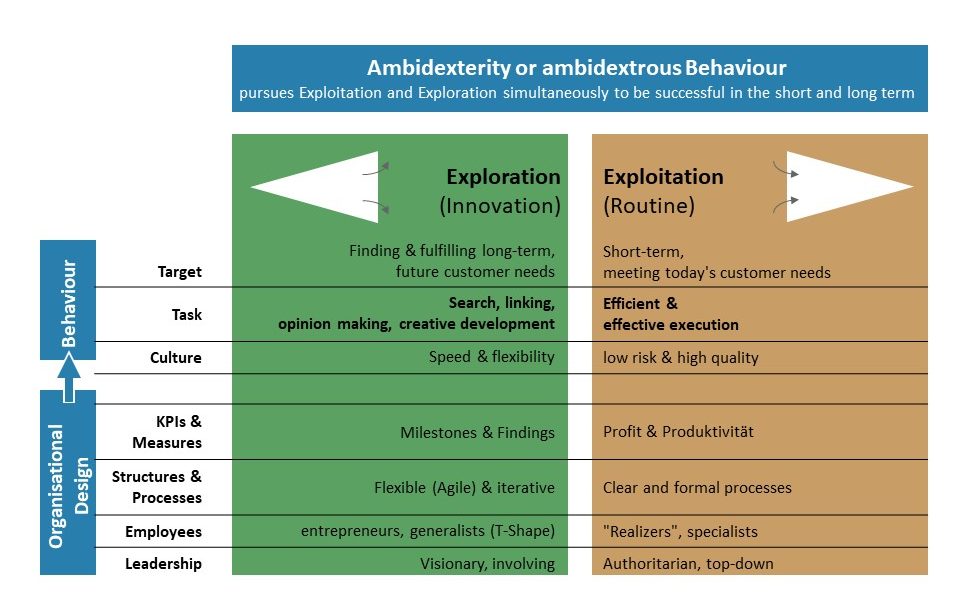“Our industry is challenged with cut-throat competition wherever we operate as there are many of us in the industry.
Every environment is a challenge for us, some more difficult than others.
If our firm does not have the capability to understand our strengths and weaknesses in light of the challenges the internal and external environment presents, and more importantly, act on it by taking advantage of opportunities and negotiating our threats, we will be finished!” (Ananthram, 2016 )
The quote above describes very well the situation that most companies face today.
Dynamic capabilities for strategic innovation
To gain strategic agility by successfully establishing and leveraging a capacity for strategic innovation, companies require specific so-called “dynamic capabilities”. A concept to describe a firm’s “ability to integrate, build, and reconfigure internal and external resources/competences to address and shape rapidly changing business environments” (Teece et al., 1997, 1990)
This set of essential competencies enable organizations to adapt to changing environments and drive strategic innovation.
Five dynamic capabilities
Based on existing literature and our own research of over 30 innovation units, five crucial dynamic capabilities stand out in this regard: scoping, configuring, sensing, seizing, and transforming.
- Scoping involves defining the boundaries and focus of innovation efforts.
- Configuring refers to the dynamic (re-)allocation of resources based on continuous assessment and prioritization of innovation efforts.
- Sensing entails perceiving changes and opportunities in the external environment and matching them with internal capabilities to identify new opportunities
- Seizing involves acting on these opportunities to capture value for the company with new solutions
- Transforming signifies the ability to reconfigure resources and processes to deploy new solutions and thus adapt to changing circumstances and drive continuous innovation.
An additional factor, People and culture is an important enabler to establish and apply these capabilities.
Together these capabilities play a vital role in fostering a culture of innovation within organizational units and drive organizational renewal and competitiveness.
Enabling and applying dynamic capabilities in innovation units
While these capabilities could be located anywhere in an organization, they are often at least partially deployed in dedicated strategic innovation units such as R&D, New Product Development, InnovationLabs and similar organizational entities.
Organizations need to integrating these capabilities into the fabric of the organization’s innovation function – through suitable processes and methods, governance mechanisms, organizational structures – to ensure that their innovation efforts are aligned with market dynamics and evolving customer needs.
Relevance for theory and practice
From a theoretical perspective, dynamic capabilities provide a comprehensive framework for understanding how organizations can adapt and thrive in complex and uncertain environments.
As the application of dynamic capabilities can empower organizations to build a sustainable competitive advantage through continuous innovation.
By leveraging the five crucial capabilities – scoping, configuring, sensing, seizing, and transforming – innovation units can effectively navigate market disruptions, capitalize on emerging trends, and drive meaningful change within their respective industries. Positioning the organization as a market leader capable of shaping industry dynamics.
Sources
Weiss, L., Kanbach, D. K., Kraus, S., & Dabić, M. (2023). Strategic corporate venturing in interlinked ambidextrous units: An exploratory model. European Management Journal.
Weiss, L., & K. Kanbach, D. (2022). Toward an integrated framework of corporate venturing for organizational ambidexterity as a dynamic capability. Management Review Quarterly, 72(4), 1129-1170.
Weiss, L., & Kanbach, D. K. (2023). Leveraging new business innovation for strategic renewal: An organizational framework for strategic corporate venturing. Creativity and Innovation Management, 32(2), 316-339.
Sauberschwarz, L., & Weiss, L. (2022). Corporates Strike Back. Springer International Publishing.
Post written by Lysander Weiss.










